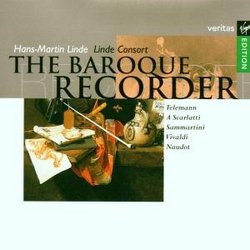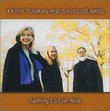| All Artists: Jacques-Christophe Naudot, Giuseppe Baldassare Sammartini, Alessandro Scarlatti, Georg Philipp Telemann, Antonio Vivaldi, Hans-Martin Linde, Linde Consort Title: The Baroque Recorder / Linde Members Wishing: 0 Total Copies: 0 Label: Virgin / Angel Records Release Date: 5/20/2000 Genre: Classical Styles: Chamber Music, Forms & Genres, Concertos, Suites, Theatrical, Incidental & Program Music, Historical Periods, Baroque (c.1600-1750), Classical (c.1770-1830), Instruments, Reeds & Winds Number of Discs: 1 SwapaCD Credits: 1 UPC: 724356124820 |
Search - Jacques-Christophe Naudot, Giuseppe Baldassare Sammartini, Alessandro Scarlatti :: The Baroque Recorder / Linde
 | Jacques-Christophe Naudot, Giuseppe Baldassare Sammartini, Alessandro Scarlatti The Baroque Recorder / Linde Genre: Classical
|
Larger Image |
CD DetailsSimilar CDs
|
CD ReviewsStunning Clarity Leslie Richford | Selsingen, Lower Saxony | 06/05/2005 (4 out of 5 stars) "This 1985 digital recording from Arlesheim/Switzerland offers an overview of concertant music for recorder from the high baroque period (first half of 18th century). Hans-Martin Linde plays copies of three different kinds of recorder (treble, discant and sopranino) and is accompanied on period instruments by a select team from his Linde Consort: Herbert Hoever and Ursula Joubert, violin, Dorothea Jappe, viola, Michael Jappe, violoncello, Christian Berg, double bass, and Rudolf Scheidegger, harpsichord). The selection of music ranges from a relatively old-fashioned sonata terza by Alessandro Scarlatti through Telemann?s ubiquitous Suite in A minor with its famous Air italienne and Polonaise through to Jacques-Christophe Naudot?s merry French concerto opus 17 Nr. 5, originally written for hurdy-gurdy and continuo.
I own six different recordings of Telemann?s Suite in A minor (four of them played on historical instruments), and I must say that of all these, it is Hans-Martin Linde?s which I like best, although he has made some performance choices (such as his exaggerated legato in the ?réjouissance?) which could be questioned, at least in detail. Linde does not attempt to set up any new speed records and plays quite straightforwardly, harvesting from one critic the comment ?industrious and musical, but uninspired?; personally, I would say that Linde really lets the music speak for itself here, with the minimal string accompaniment making for stunning clarity, supported by the wonderfully clear engineering with its absolutely transparent sound. There are a couple of weaknesses to be heard in the slow movements of the pieces by Sammartini (a rather nervous beginning) and Vivaldi (the harpsichord takes a break but leaves behind it something of a musical gap), but the faster outer movements give ample recompense with some wonderful playing. The same critic mentioned above called Linde?s playing on the Scarlatti ?sober?, but I felt it was exactly on target for this style of music. And on the Naudot, nobody could feel anything but joie de vivre (assuming that one can bear listening to that high-pitched sopranino); the piece is definitely worth listening to in the version for recorder (which the composer specifically allowed for). " |

 Track Listings (21) - Disc #1
Track Listings (21) - Disc #1
